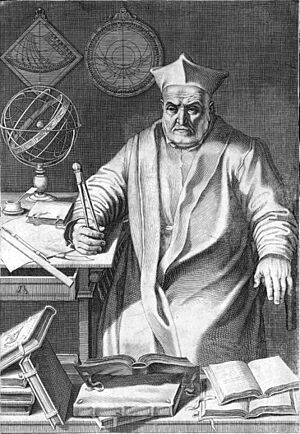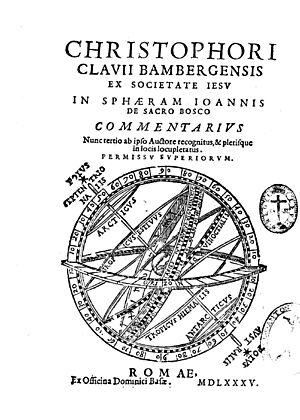Christopher Clavius facts for kids
Quick facts for kids
The Reverend
Christopher Clavius
|
|
|---|---|
 |
|
| Born | 25 March 1538 |
| Died | 6 February 1612 (aged 73) |
| Nationality | German |
| Alma mater | University of Coimbra |
| Known for | Gregorian calendar, Clavius' Law |
| Scientific career | |
| Fields | Mathematics, astronomy |
| Institutions | Collegio Romano |
Christopher Clavius (born March 25, 1538 – died February 6, 1612) was a German Jesuit priest, a brilliant mathematician, and an astronomer. He was the head of mathematicians at the famous Collegio Romano in Rome. Clavius played a very important role in creating the Gregorian calendar, which is the calendar we use today all over the world.
He was part of a special group at the Vatican that approved the new calendar. He later wrote books explaining and defending it. Towards the end of his life, he was one of the most respected astronomers in Europe. His textbooks were used to teach astronomy for over 50 years.
Contents
Early Life and Studies
We don't know much about Clavius's early life. He was born in Bamberg, Germany, around 1538. His real name might have been Christoph Clau or Klau. Some people think his chosen name, Clavius, comes from the Latin word clavis, meaning 'key'. His original German name might have been Schlüssel, which also means 'key'.
Clavius joined the Jesuit order in 1555. He studied at the University of Coimbra in Portugal. He then went to Rome to study theology at the Jesuit Collegio Romano. He became a priest in 1564.
Creating the Gregorian Calendar
About 15 years later, Clavius was asked to help fix the calendar. The old calendar caused church holidays to slowly drift away from the seasons. He used earlier work by Aloysius Lilius to propose a new calendar.
This new calendar was adopted in 1582 by Pope Gregory XIII. It is now known as the Gregorian calendar and is used worldwide.
Mathematics and Decimal Points
Within the Jesuit order, Clavius worked hard to make sure mathematics was taught properly. At that time, some people didn't think mathematics was important.
In logic, there's a rule called Clavius' Law. It's named after him. This law helps prove something is true by showing that its opposite leads to a contradiction.
Clavius was also one of the first people in the West to use the decimal point. He used it in his tables for measuring angles in 1593.
Astronomy and the Heavens
Clavius wrote an important book explaining De Sphaera by Johannes de Sacrobosco. This was a very popular astronomy textbook in the Middle Ages. Clavius's book became one of the most important astronomy textbooks of his time. It was printed at least 16 times between 1570 and 1618. Clavius himself updated it seven times, making it much bigger each time.
In 1585, Clavius wrote about a new bright star (a nova) that appeared in 1572. He found that this new star was in the same spot for everyone who observed it. This meant it had to be very far away, beyond the Moon. This discovery helped show that the heavens could change, which was a big deal at the time.
Earth at the Center
As an astronomer, Clavius believed in the geocentric model. This idea says that the Earth is at the center of the universe, and everything else, like the sun and planets, goes around it. He didn't agree with Copernicus's idea that the sun was at the center (the heliocentric model). However, Clavius did see some problems with the older model by Ptolemy.
Meeting Galileo
Clavius was highly respected by Galileo. Galileo visited him in 1611 to talk about new discoveries made with the telescope. By then, Clavius had accepted that these new discoveries were real. But he still wasn't sure about the mountains on the Moon. He also said he couldn't see Jupiter's four largest moons through the telescope.
Later, a large crater on the Moon was named Clavius in his honor.
Collegio Romano and Teaching
At the Collegio Romano, Clavius was the head of the mathematicians. He was also a public professor of mathematics. He directed advanced teaching and research at the Academy of Mathematics until 1610, and then informally until 1612.
The Academy of Mathematics had been around for a while, but it wasn't officially recognized. In 1580, Clavius wrote a detailed plan for a mathematics curriculum. He wanted the College to officially recognize the Academy. He suggested three different courses: one year, two years, and three years. These courses would cover optics, statics, astronomy, and acoustics, with a strong focus on mathematics.
His request was first denied, but he was still given the title of Professor of Mathematics. Clavius tried again in 1586 to make the Academy official, but some philosophers at the College disagreed. The Academy finally became an official part of the College around 1593 or 1594.
Once it was official, students needed to be nominated by the Professor of Mathematics to join. Clavius taught the advanced course. The Academy's main goal was to train skilled specialists and new teachers. It also aimed to train missionaries who needed math skills for their work in faraway places.
Clavius and Galileo often wrote letters to each other. They discussed proofs and theories. It's thought that Clavius shared his notes from the College's logic course to help Galileo explain his ideas better.
After Clavius died in 1612, informal math courses continued at the College. However, the Academy's official recognition seems to have ended a few years later.
Selected Works
- Commentary on Euclid, 1574 (A book explaining Euclid's famous geometry work)
- Gnomonices libri octo, 1581 (A book about gnomonics, the study of sundials)
- Novi calendarii romani apologia, Rome, 1588 (A defense of the new Roman calendar)
- Astrolabium, Rome, 1593 (A book about the astrolabe, an old tool for astronomy)
- Romani calendarii a Gregorio XIII P.M. restituti explicatio, Rome, 1603 (An explanation of the Gregorian calendar)
- Romani calendarii a Gregorio XIII P.M. restituti explicatio. (European Cultural Heritage Online)
- Romani calendarii a Gregorio XIII P.M. restituti explicatio. (University of Notre Dame)
- Refutatio cyclometriae Iosephi Scaligeri, Mainz, 1609
- Elementorum Libri XV, Cologne, 1627 (Published online by the Sächsischen Landesbibliothek - Staats- und Universitätsbibliothek Dresden)
Clavius's complete mathematical works (5 volumes, Mainz, 1611–1612) are available online.
Images for kids
See also
 In Spanish: Cristóbal Clavio para niños
In Spanish: Cristóbal Clavio para niños
- Asteroid 20237 Clavius
- Clavius (crater), a lunar crater named after Clavius
- Clavius Base, located in Clavius crater, in both the novel and film versions of 2001: A Space Odyssey
- Aloysius Lilius
- Computus
- List of Jesuit scientists
- List of Roman Catholic scientist-clerics
- Bracket (mathematics)




